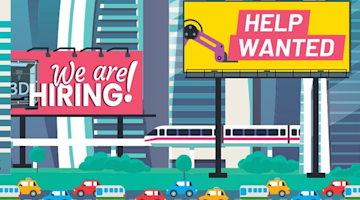Automation and other advanced technologies are enabling manufacturing companies to be more efficient, productive, and cost effective, while also reducing barriers and making it easier than ever for manufacturers to hire workers they may have not previously considered.
Start with “Can-do”
“We've got to start thinking about the skills people with disabilities bring to the table and the work that they can do, especially using existing technology in many manufacturing facilities. It opens up new careers that can help address the employee shortage in manufacturing,” says Bridget Hayman, director of communications at Access Living, a service and advocacy center for people with disabilities in Chicago.
According to a 2018 Accenture study, if employers embraced disability inclusion, U.S. companies would gain access to a new talent pool of more than 10.7 million people.
During a workshop presentation at IMTS 2022, Hayman was part of a panel discussion that highlighted manufacturers’ successes in leveraging technology to address accessibility in the work environment. The discussion was led by Liz Stuck, vice president of MxD Learn, which provides workforce development services for manufacturers. MxD, alongside several partners such as Access Living and the College of Lake County, is currently developing Learn and Earn, a program that educates and supports manufacturers that hire people with disabilities. Results of that pilot program will be shared in 2024.
Capitalize on Automation
The term “disability” is a broad term, legally defined under the Americans with Disabilities Act as any mental or physical impairment that impacts one or more major life activity. Many disabilities, especially cognitive and mental challenges, are not readily apparent compared to seeing someone who is deaf, blind, or in a wheelchair.
“With such a wide variety of disabilities, we need to think more about universal design and how to use technology to make manufacturing workspaces more accommodating for everyone to do their job well,” Hayman says. “It's not necessarily about accommodating one person with a specific type of disability.”
Automation technology already in use provides an easier environment for people with disabilities. For example, a person with limited mobility or restricted hand control may be able to operate a machine with a touchscreen interface and work alongside cobots to load and unload parts.
GenMet Rethinks its Welding Booths
One manufacturer is already making accommodations to promote accessible workplaces: GenMet in Mequon, Wisconsin. When one of the company’s welders was severely injured in a snowmobile accident and left paralyzed from the waist down, he thought his career was over.
Eventually the welder returned to his job at GenMet, and Company President Mary Isbister was happy to welcome him back. Working with the rest of the welding team, GenMet modified a welding booth to accommodate a wheelchair with a height-adjustable table, overhead jib cranes to handler larger parts, and a different organization system for parts and tools to be more readily accessible. The worker is back to his usual level of productivity and quality.
“It wasn’t that difficult, and we didn’t spend a lot of money to make those accommodations to the welding booth,” Isbister says. “At that point, we knew that if we could accommodate one person with a disability, we knew we could do it with multiple people.”
Rethinking Clerical Work
GenMet has hired individuals with intellectual disabilities to do administrative tasks, which just required some extra fixturing on the filing system for easier access and clarity. Over the years, GenMet has hired a number of individuals with intellectual disabilities in which no physical adaptations were required, but needed modifications to the way information is shared.
“They have a certain way of processing information, so we give them projects individually instead of an entire week’s work. Then they can focus on the immediate task,” Isbister adds. “In fact, one of these team members is so focused that he’s perfect for helping the rest of the team on more complex work that requires great precision. They call him in when they need help on tricky jobs.”
GenMet hopes to continue hiring more workers with a range of disabilities because the company has witnessed a population of people that are committed to their work and productive additions to the shop.
“Our employees with disabilities show up every day and work hard. They don't take the work for granted,” Isbister says. “They understand that we’re happy to make the accommodations to have them on staff, and we want them to feel completely part of the team, no matter what.”
Resources
For guidance on how to make job accommodations for workers with disabilities, visit the Job Accommodation Network website.
Read real-life case studies about accommodating workers in manufacturing settings, visit the JAN case studies web page.
To learn about tax benefits for smaller companies that have employees with disabilities, visit the IRS website.





